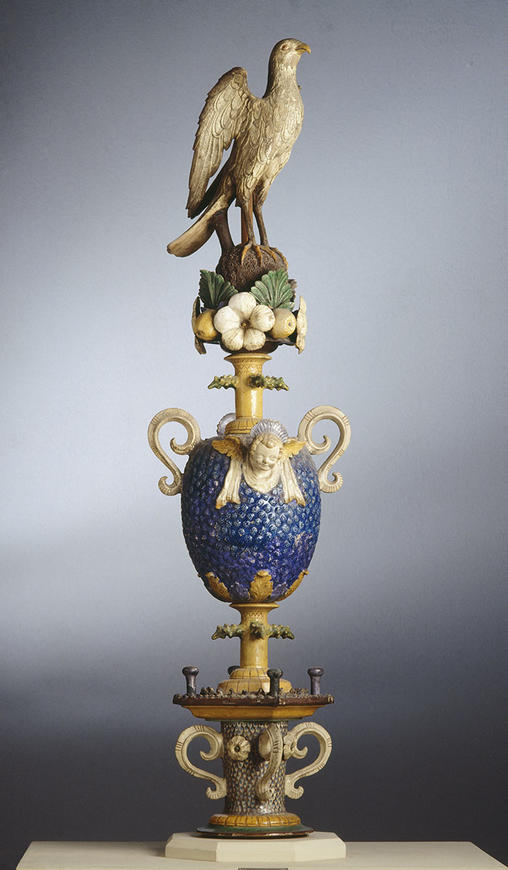This ridge finial is composed of several elements fitted onto a metal shaft, which was itself attached to a ridge tile, now missing. The cylindrical base is decorated with four handles and supports a square platform. The central part has an oval blue shape reminiscent of a vase or ostrich egg. Two handles and two crowned cherub heads adorn its surface. The top is composed of a bouquet of flowers, serving as a nest for an eagle.
This magnificent spire is a sign of wealth for the owner of the house or castle it adorns. It is a landmark visible from afar in the landscape.
Roof finials have been around since the 13th century, but the first ones were made of lead. It wasn't until the 16th century that more decorative ceramic finials, like this one, began to appear. The Pays d'Auge region, and more specifically the villages of Manerbe and Pré d'Auge, specialize in their production. The finials from this region are made of terracotta. A transparent, lead-based glaze or enamel is added to the clay, giving the piece its shine.
The colors are obtained by adding metal oxides, which become colored during firing: blue is obtained by oxidizing cobalt, green by oxidizing copper, yellow by oxidizing iron, etc.
Bonus info: The Sars-Poteries region (Nord) preserves the tradition of ridge tiles. Smaller in size, they are made of glass, as the soil in the surrounding area is rich in silica, which is necessary for the manufacture of this material.

This ridge finial is composed of several elements fitted onto a metal shaft, which was itself attached to a ridge tile, now missing. The cylindrical base is decorated with four handles and supports a square platform. The central part has an oval blue shape reminiscent of a vase or ostrich egg. Two handles and two crowned cherub heads adorn its surface. The top is composed of a bouquet of flowers, serving as a nest for an eagle.
This magnificent spire is a sign of wealth for the owner of the house or castle it adorns. It is a landmark visible from afar in the landscape.
Roof finials have been around since the 13th century, but the first ones were made of lead. It wasn't until the 16th century that more decorative ceramic finials, like this one, began to appear. The Pays d'Auge region, and more specifically the villages of Manerbe and Pré d'Auge, specialize in their production. The finials from this region are made of terracotta. A transparent, lead-based glaze or enamel is added to the clay, giving the piece its shine.
The colors are obtained by adding metal oxides, which become colored during firing: blue is obtained by oxidizing cobalt, green by oxidizing copper, yellow by oxidizing iron, etc.
Bonus info: The Sars-Poteries region (Nord) preserves the tradition of ridge tiles. Smaller in size, they are made of glass, as the soil in the surrounding area is rich in silica, which is necessary for the manufacture of this material.